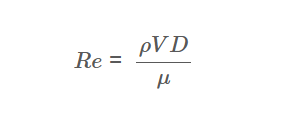1. What is a Reynolds Number Calculator?
Definition: This calculator computes the Reynolds number (\( Re \)), a dimensionless quantity used to determine the flow regime (laminar, transitional, or turbulent) in pipes or ducts.
Purpose: It is used in HVAC systems to classify flow regimes, which affects pressure drop, heat transfer, and system design.
2. How Does the Calculator Work?
The calculator uses the Reynolds number formula:
Reynolds Number:
\[
Re = \frac{\rho V D}{\mu}
\]
Where:
- \( Re \): Reynolds number (dimensionless)
- \( \rho \): Fluid density (lb/ft³, kg/m³)
- \( V \): Velocity (ft/s, m/s)
- \( D \): Characteristic length (ft, in, m, e.g., pipe diameter or hydraulic diameter)
- \( \mu \): Dynamic viscosity (lb/ft-s, Pa-s)
Unit Conversions:
- Fluid Density (\( \rho \)): lb/ft³, kg/m³ (1 kg/m³ = 0.062428 lb/ft³)
- Velocity (\( V \)): ft/s, m/s (1 m/s = 3.28084 ft/s)
- Characteristic Length (\( D \)): ft, in (1 in = \( \frac{1}{12} \) ft), m (1 m = 3.28084 ft)
- Dynamic Viscosity (\( \mu \)): lb/ft-s, Pa-s (1 Pa-s = 0.671969 lb/ft-s)
Steps:
- Enter the fluid density (\( \rho \)), velocity (\( V \)), characteristic length (\( D \)), and dynamic viscosity (\( \mu \)), and select their units.
- Convert all inputs to base units (\( \rho \) to lb/ft³, \( V \) to ft/s, \( D \) to ft, \( \mu \) to lb/ft-s).
- Calculate the Reynolds number using \( Re = \frac{\rho V D}{\mu} \).
- Determine the flow regime (laminar: \( Re < 2300 \), transitional: \( 2300 \leq Re \leq 4000 \), turbulent: \( Re > 4000 \)).
- Display the result, using scientific notation for values less than 0.001, otherwise with 4 decimal places.
3. Importance of Reynolds Number Calculation
Calculating the Reynolds number is crucial for:
- HVAC Design: Determines the flow regime, which affects pressure drop and heat transfer calculations in ducts and pipes.
- Energy Efficiency: Helps optimize system design by predicting flow behavior, reducing energy losses.
- System Performance: Ensures proper flow characteristics for efficient operation of HVAC systems.
4. Using the Calculator
Examples:
- Example 1: For \( \rho = 0.075 \, \text{lb/ft}^3 \), \( V = 10 \, \text{ft/s} \), \( D = 0.5 \, \text{ft} \), \( \mu = 1.2 \times 10^{-5} \, \text{lb/ft-s} \):
- Reynolds Number: \( Re = \frac{0.075 \times 10 \times 0.5}{1.2 \times 10^{-5}} = 31250.0000 \)
- Flow Regime: Turbulent (Re > 4000)
- Example 2: For \( \rho = 1.2 \, \text{kg/m}^3 \), \( V = 0.5 \, \text{m/s} \), \( D = 0.1 \, \text{m} \), \( \mu = 1.8 \times 10^{-5} \, \text{Pa-s} \):
- Convert: \( \rho = 1.2 \times 0.062428 = 0.0749136 \, \text{lb/ft}^3 \), \( V = 0.5 \times 3.28084 = 1.64042 \, \text{ft/s} \), \( D = 0.1 \times 3.28084 = 0.328084 \, \text{ft} \), \( \mu = 1.8 \times 10^{-5} \times 0.671969 = 1.20954 \times 10^{-5} \, \text{lb/ft-s} \)
- Reynolds Number: \( Re = \frac{0.0749136 \times 1.64042 \times 0.328084}{1.20954 \times 10^{-5}} \approx 3333.3333 \)
- Flow Regime: Transitional (2300 ≤ Re ≤ 4000)
5. Frequently Asked Questions (FAQ)
Q: What is the Reynolds number?
A: The Reynolds number (\( Re \)) is a dimensionless quantity that indicates the flow regime (laminar, transitional, or turbulent) in a fluid system, calculated as \( Re = \frac{\rho V D}{\mu} \).
Q: Why is the Reynolds number important in HVAC systems?
A: It determines the flow regime, which affects pressure drop, heat transfer, and overall system design in HVAC ducts and pipes.
Q: How do I determine the characteristic length (\( D \))?
A: The characteristic length (\( D \)) is typically the pipe diameter for circular pipes or the hydraulic diameter for non-circular ducts, calculated as \( D_h = \frac{4A}{P} \), where \( A \) is the cross-sectional area and \( P \) is the wetted perimeter.
Reynolds Number Calculator© - All Rights Reserved 2025
 Home
Home
 Back
Back
